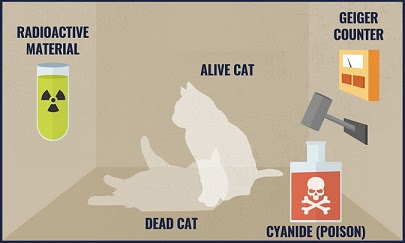Schrödinger’s Cat: Groundbreaking, Crazy, or Both?

October 16, 2021
Erwin Schrödinger, an Austrian physicist, conjured his famous “Schrödinger’s Cat” conundrum in 1935. The basis of the problem reads as follows:
A cat is placed in a box containing a hammer situated over a vial of cyanide. A Geiger counter, which can detect radiation, is aimed at a sample of radioactive uranium. This uranium sample adheres to the standard laws of quantum mechanics. It remains unsure whether the sample will emit radiation. If it does, the Geiger counter will release the hammer: smashing the vial and lethally poisoning the cat.
While this experiment was never conducted by Schrödinger, he proposed it to demonstrate the sheer craziness behind the speculations of another renowned theoretical physicist of his time, Niels Bohr.
Bohr believed that quantum mechanics depends on the uncertainty of states up until the point of measurement, indicating a period of superposition, in which two varying states exist at the same time. Thus, the true state of an object, such as an electron, or in this case, a cat, can only be definitively determined following measurement.
By translating this principle into a real-world experiment, Schrödinger hoped to demonstrate how far-off this idea was. How could a cat be both alive and dead at the same time? Albert Einstein agreed with Schrödinger, claiming that quantum states depending on our consciousness was absurd, even more so when applied to the macroscopic world.
Schrödinger’s experiment was placed on the back burner for decades, as scientists grew increasingly convinced of the distinction between life at the quantum level and that of the visible world.
However, since the 1970s, scientists have proven that the line between the quantum world and that of everyday life is much finer than we initially thought. Properties that were first attributed to subatomic particles were applied to larger groups of atoms, and the observations were startling. For instance, a 2019 experiment showed the existence of 2000 atoms in two different places at the same time!
The controversy surrounding Schrödinger’s Cat can be traced back to the uncertainty that persists today:
Where do the rules governing subatomic particles shift to match those of the macroscopic world, and do these rules differ at all?
These are major questions that today’s theoretical physicists hope to answer. It may soon be proven that Schrödinger’s cat experiment was not so otherworldly after all.
Sources:
